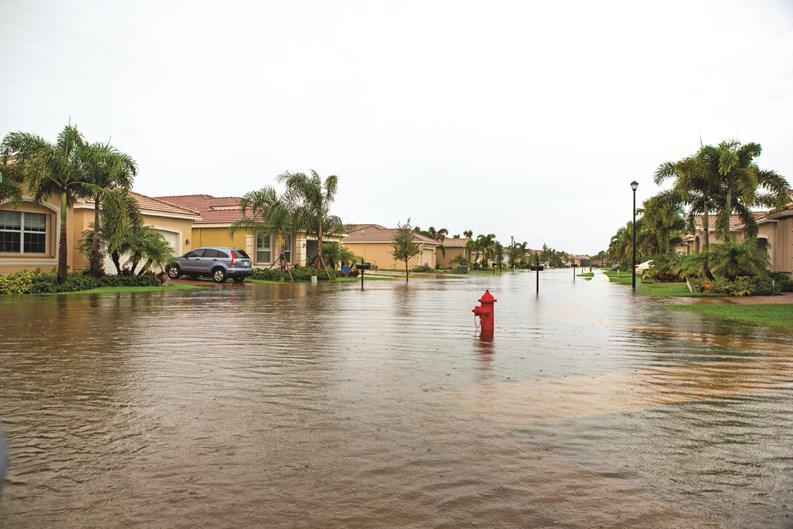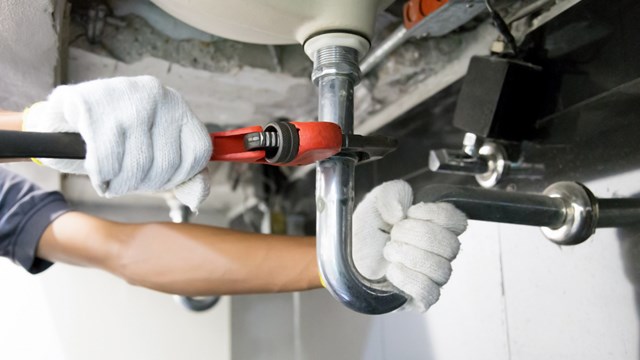*Editor's note: In anticipation of Hurricane Irma's possible landfall in Florida later this week, The South Florida Cooperator is featuring a selection of past articles on storm preparation, emergency planning, and post-storm clean-up. Florida readers are encouraged to pay close attention to federal, state, and local emergency information sources, follow any and all preparation and evacuation orders, and most of all, stay safe!
Florida is well known for sunshine, amusement parks, vacations, and a retirement destination. But there's another side to the Florida lifestyle that's not so popular, and that's the extreme weather that comes with hurricane season. Sporadic weather woes are just the price of admission for the mostly sunny, subtropical area known as South Florida.
The Quiet Before the Storm
Named, or not, destructive weather events require a game plan in three parts: before, during, and after the storm. Prior planning for disastrous weather can greatly reduce the post-storm cleanup. William and Susan Raphan are statewide education facilitators for Katzman Garfinkel, a community association law firm that has offices all over South Florida.The Raphans teach a pro-active class on hurricane preparedness for community boards and associations. “Boards of directors in community associations cannot become complacent and jeopardize their community by not preparing for a hurricane or a major disaster that could happen at any time,” says William Raphan. “Just because we have not had a major storm for many years does not mean we won’t have one this year. It only takes one storm to do sufficient damage to make an entire community shut down.”
The couple teaches from a simple checklist that breaks down the necessary steps to be thoroughly prepared for dangerous weather. Their first suggestion is to review contracts with any and all vendors whose assistance may be needed after a storm. If contracts need to be reviewed, updated, or replaced, the time to accomplish that business is before extra services are required. Vendors such as landscapers, security, elevator maintenance, and HVAC contractors may be needed to restore the property and the residents' safety and peace of mind following a storm.
Another key suggestion is to meet with the property manager, or management company, to be sure everyone is on the same page. With proper communication, necessary assistance can be provided to facilitate recovery plans.
The Raphans also suggest the board appoint a hurricane committee to identify residents with special needs, and to accumulate a list of contact numbers for assistance agencies. The list should be given to all residents along with instructions in the case of a possible evacuation.
Along with reviewing vendor contracts, all other important documents should also be examined. Insurance policies, contracts, financial records, rosters, computer records, and employee information should be secured on-site, and preferably in an off-site database as well.
General preparations should include knowledge of water shutoff valves, electrical circuit breakers, fire extinguishers, and sewer line cleanouts. The location of defibrillators and first aid supplies should be noted.
Before the designated beginning of hurricane season, generators should have regular routine service, and trees should be well trimmed. The Miami-Dade website, (www.miamidade.gov /hurricane/after.asp) cites the importance of properly trimming trees and shrubs prior to hurricane season to reduce debris that can be generated during a hurricane or storm. Proper tree pruning also increases the likelihood of the tree surviving a storm, which protects the properties’ landscape investments.
Hip Deep in Alligators
There is a saying that says, “The best time to drain the swamp is not when you are hip deep in alligators.” And that is a truism, quips Turner Billups, senior vice president of FirstService Residential Florida. “If you are under hurricane watch, it is too late to train the staff on what to do. The building staff should be on-site preparing and securing the entire property prior to the storm, and they should return as soon as safely possible.”If you are riding out a storm in your home, it's important to monitor the radio and television (if power is not compromised) for weather updates and public safety instruction. The Miami-Dade website recommends staying indoors, away from windows, and to avoid using the phone or showering. If you lose power, turn off all major appliances, and if flooding is a threat, turn off the main breaker.
Flashlights rather than candles or kerosene lamps provide safer illumination. Keep children informed about what is happening. Keep pets in their carriers, in the event of an evacuation it will be easier to move a frightened animal.
Finally, never go outside during the “eye of the storm.” That brief period of calm can quickly turn deadly when the storm resumes. If evacuation is recommended, a floor captain or point person for each floor is crucial. Someone who knows the residents and has knowledge of any disabled persons, children, and pets is beneficial to both the evacuation and the re-entry process.
Rally points should be established and advertised to residents well in advance. Residents should be instructed to report to those locations for safety and information. Restaurants, libraries, and other public buildings are usually excellent rally points.
The board, property manager, staff, and hurricane committee also need a rally point or command center as close to the property as possible. “The board should be available to communicate with the manager and other board members as early as possible following the storm,” says Billups.
The Business End of Recovery
After the winds die down and the waters recede, it's time for what may be the hardest part—cleaning up after a major weather event, and restoring the property and lifestyle. “A property manager’s role is to immediately assess the situation and determine if there is any actual damage, water intrusion, and downed power lines,” states Billups. “The municipality or utility companies are responsible for restoring water, gas, and electricity as quickly as possible; however, a good manager will have topped off the generators with fuel, particularly during hurricane season.”Billups suggests a property manager have a protocol in place for fuel deliveries to arrive as soon as possible after a storm, in case the power is out for an extended period of time.
Daniel Odess, president of GlobalPro Recovery, Inc. in Coral Gables, says, “The key to ensuring a proper recovery from an insurable loss is patience. Too often management and staff run to clean up and make repairs without properly documenting the damage in an effort to clean up and get back to normal.”
Odess and Billups both recommend documenting the damage with photos and then calling the insurance company. Odess further suggests mitigating additional damage by boarding up windows, and using tarps wherever needed. After you have documented and mitigated the damages, Odess suggests you allow the insurance company to inspect and submit the claim. He further recommends recovery of the insurance funds before any rebuilding takes place. “Don’t sacrifice your recovery; take your time and protect the financial interest of the association,” he says.
Odess finds the most serious damage after a severe storm or hurricane is generally to roofs, windows, and landscaping. Billups’ checklist for the most common high-rise damages includes windows and roofs, and also cooling towers, elevators, flooding in lower level garages, balcony railings, and exterior lighting.
“Keep in mind a window doesn’t have to be blown in to be damaged, just like a roof doesn’t have to be blown off to be damaged,” says Odess. He recommends opening and closing every window and checking the seals; always check the roof for water intrusion. If you have a roofing maintenance agreement, have your contractor check for any loose or damaged flashing around penetrations or displaced gravel. This can help your association avoid water intrusion issues being blamed on wear and tear and long-term deterioration.
“Lastly, check drains to make sure they are free of debris before and after a storm to avoid any above-ground flooding or backups, most often not covered by insurance, states Odess. The board and management have a fiduciary responsibility to the association and must protect the association’s interest.”
Where to Find Help
A property manager’s role in post-storm cleanup and repair is simply ensuring the safety of the owners,” says Odess. Always defer to your experts and seek the advice of a professional, but whenever possible work with your usual vendors who are familiar with the property. Post-storm repair is not the best time to bring in a new contractor.The building staff should assist the association and the property manager in collecting and documenting the information on damages. The Federal Emergency Management Agency (FEMA) may be able to provide recovery resources after a major weather event. Call 800-621- 3362 or apply at www.DisasterAssistance.gov. The South Florida Region of the American Red Cross may be reached at 305-644-1200 or at www.RedCross.org/fl/ miami. The Florida Division of Emergency Management may be reached at 850-413-9969 or at www.FloridaDisaster.org.
Additionally, associations and boards should take advantage of all local disaster planning classes offered by local government offices. In the Miami-Dade area, the Community Emergency Response Team (CERT) Program is available to educate interested individuals in disaster preparedness, basic response skills, and disaster medical operations. Classes are a combination of online and in the classroom with hands-on exercises. More information is available at www.citzen corps.gov/cert/ training.
Since it is not a matter of if, but when, a severe storm or hurricane will strike, a board can be proactive by taking local classes such as CERT, and continuing to find informational resources like The South Florida Cooperator.
Anne Childers is a freelance writer and a frequent contributor to The South Florida Cooperator.







Leave a Comment